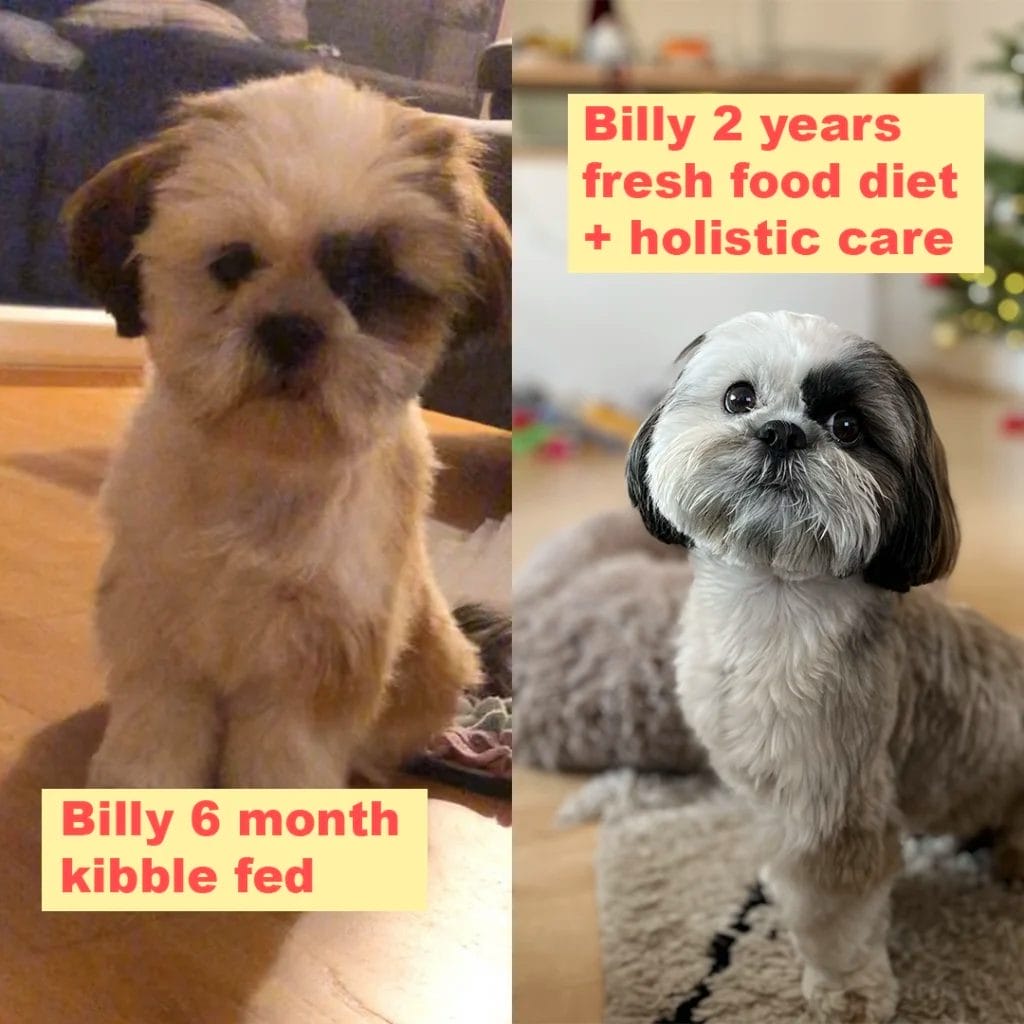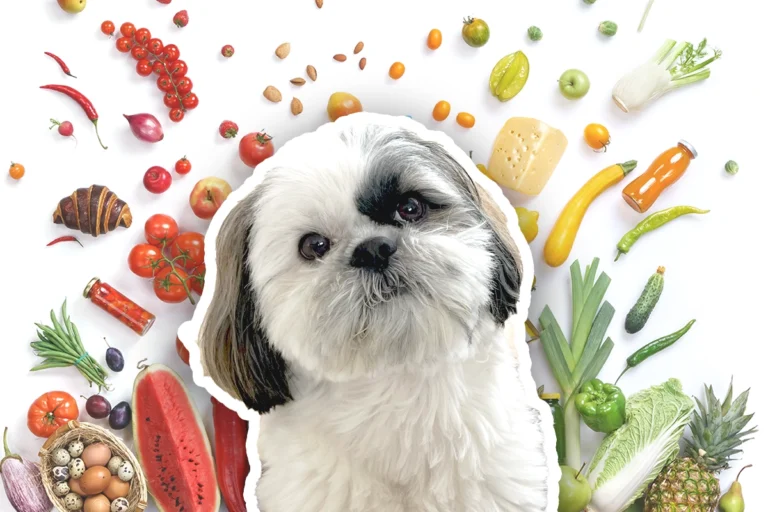How to Start Feeding Fresh Food for Shih Tzu 2025
When I decided to switch Billy, my Shih Tzu, to a fresh food diet, I didn’t know what to expect.
But looking back, I can confidently say it was one of the best decisions I’ve ever made for his health and happiness.
Fresh food has transformed his life—and mine—in ways I couldn’t have imagined.
And I want to help you transition your Shih Tzu to fresh food.
In this article, I will share my journey, the mistakes I learned from, and the incredible benefits I’ve seen firsthand.
Key Takeaways:
- Fresh food can significantly improve a Shih Tzu’s health.
- Transition methods include cold turkey for healthier dogs or gradual transition for those used to processed diets.
- Feed 2-3% of your dog’s ideal body weight daily, ensuring meals are balanced and meet caloric needs.
- Avoid overfeeding, introduce variety, and focus on progress rather than perfection during the transition.
- Use available resources and expert guidance to confidently switch to a species-appropriate diet.
Why I Switched My Dog to Fresh Food
I started to question the quality of Billy’s kibble after noticing recurring issues with his digestion, anal glands, ears, and eye inflammation.
Most commercial dog food is highly processed and packed with artificial preservatives and fillers.1
One of the most well-known holistic vets (whom I learned a LOT from), Dr Nick Thompson, said in an interview with the channel The Dog Nutritionist…
...Over the last thirty years we’ve been feeding more and more and more kibble…(dogs are) more prone to diabetes, heart disease, liver disease, kidney disease; your (dogs’) quality of life is poor and, as I say, two years off their life…
He continued to say…
…I think we should feed our dogs a species-appropriate food; if you can make your diet in the kitchen, great…
Thompson, N. (n.d.). Why is dry dog food so unhealthy? [Video]. The Dog Nutritionist. YouTube.2
When I learned that fresh food could provide more nutrients, improve digestion, and support a healthier coat, I knew I had to try it.
After switching, I saw improvements in Billy’s health fairly quickly.
His coat became shinier and softer, his eyes absolutely brightened up, and his persistent digestive issues disappeared.
The difference was night and day, and I knew I’d made the right choice for my Shih Tzu.
Bonus: Download FREE Shih Tzu Herbal Tea Handbook ➔

What I learned from my journey switching from a kibble to a fresh food diet:
Before I Transitioned Billy to Fresh Food…
Switching Billy’s diet wasn’t something I did overnight. I had the same doubts that you might be experiencing right now, like:
Will I be able to provide all the nutrients Billy needs?
Can I do everything right?
How do I even start?
It’s completely normal to feel unsure.
The good news is that you don’t have to figure it all out on your own.
Today, with so many resources available, the best way to overcome these doubts is to ask questions, seek guidance, and take the time to learn.
Research and Plan
The first thing I did was do deep research and learning.
Shih Tzus are a small breed with unique calorie and nutrient requirements, so I wanted to ensure I was feeding him a balanced diet that provides all necessary nutrients.
Here is the list of holistic vets and online resources that I learn from:
If you are interested, I found this video from Dr. Judy Morgan very helpful for beginners:
How Can You Transition Your Shih Tzu to a Fresh Food Diet?
So, there are only two ways to transition any dog from a commercial diet to a fresh food diet:
- Cold Turkey3 and
- Gradual Transition.
Which Method to Choose? (and what I chose for Billy)
The decision depends on how long your dog has been eating a commercial diet.
The longer your dog has consumed highly processed food, the less prepared their gut may be to handle the switch to fresh food.
When I switched Billy to a 100% fresh food diet, he was only 8 months old.
His young age and relatively short exposure to kibble made his gut more adaptable, so I chose to switch cold turkey.
1. Cold Turkey
What is Cold Turkey?
Switching cold turkey means replacing your dog’s entire diet with fresh food immediately, without mixing in any commercial food.
This method works well for younger dogs or those with strong digestive systems.
However, it’s essential to monitor your dog for any signs of digestive upset, such as diarrhea or vomiting, and consult a holistic veterinarian if needed.
But if your dog has been on a commercial diet for years, and you want to take it slow, a gradual transition is a better choice.
Bonus: Download FREE Shih Tzu Herbal Tea Handbook ➔
2. Gradual Transition
Begin by mixing a small portion of fresh food with your dog’s current diet, such as kibble or dry dog food.
Gradually increase the percentage of fresh food over 7-10 days4:
Days 1-3: 25% fresh food, 75% current diet.
Days 4-6: 50% fresh food, 50% current diet.
Days 7-9: 75% fresh food, 25% current diet.
Day 10: 100% fresh food.
This slow transition allows your dog’s digestive system to adjust to the new diet, minimizing the risk of upset stomachs.
BONUS: Treats Matter!
Treats are also part of the overall diet that we cannot skip.
Choosing the right treats can complement a fresh food diet and reinforce healthy eating habits.
I discovered Owa Owa, a company that offers 100% homemade, preservative-free treats made from wholesome ingredients.
These natural treats are the perfect addition to Billy’s diet, providing extra nutrients and a way to reward him.
Plus, their high-quality ingredients ensure I’m not introducing any fillers or artificial additives into his diet.
Knowing the treats are healthy makes it even more satisfying to see him enjoy them.
Now, you can get an exclusive 10% discount on Owa Owa with our code: billyspaw
How Billy enjoys his Owa Owa treats:
Tips for a Successful Transition
Monitor Digestive Health Keep a close eye on your dog’s stools during the transition. Diarrhea or constipation may indicate the need for adjustments.
Incorporate Variety Gradually Introduce new proteins and vegetables one at a time to identify any potential allergies or intolerances.
Be Patient Some Shih Tzus, especially picky eaters, may take time to accept a fresh food diet. Offer encouragement and stick to the routine, and they’ll likely come around to enjoy their meals.
Bonus: Download FREE Shih Tzu Herbal Tea Handbook ➔
3 Mistakes I Made—and How You Can Avoid Them
Like any new venture, I made a few mistakes along the way.
1. Overfeeding
When I first transitioned Billy to a fresh food diet, I struggled to find the right amount of food.
At first, I underfed him, and his weight dropped quickly.
I then increased his portions, but this led to overfeeding.
Billy began vomiting almost every other day and had frequent loose stools, which was a clear sign that I was giving him too much.
The golden rule I’ve learned is to feed 2-3% of your Shih Tzu’s ideal body weight in food per day.
Pets will consume an average of two to three percent of body weight per day…Larger breeds tend to need a lower percentage than smaller breeds with higher metabolism…
You should feed based on the ideal body weight, not the current body weight.
Grant, H., & Morgan, J. (n.d.). Yin & Yang nutrition for dogs: Maximizing health with whole foods, not drugs (p. 16). Naturally Healthy Publications.
This portion should also meet their caloric requirements based on their activity level and life stage.
Measuring food portions accurately and adjusting based on your dog’s response is crucial to their health and digestion.
2. Lack of Variety
When I first started feeding Billy fresh food, I stuck to just 1 to 2 proteins.
However, I soon learned that rotating proteins help prevent nutrient deficiencies.5
Each protein source offers unique amino acids and nutrients that contribute to a well-rounded diet.
The same principle applies to vegetables and fruits.
3. Overthinking
When I began this journey, I found myself overanalyzing every detail of Billy’s diet.
I worried constantly—was I including enough nutrients?
Was I using the right supplements?
Was I preparing everything perfectly?
This overthinking became overwhelming and even made me question if I was capable of providing a proper fresh food diet.
Here’s what I’ve learned: feeding fresh food doesn’t have to be perfect to be beneficial.
Start with the basics and build your confidence as you go.
Using reputable resources for recipes can help alleviate concerns.
Over time, you’ll find a way that works for you and your Shih Tzu.
Remember, progress is better than perfection.
Ready to Start Feeding Fresh Food?
If you’re considering making the switch, I encourage you to take the leap.
Feeding fresh food is an investment in your Shih Tzu’s health and longevity.
To make it easier, I’ve compiled everything I’ve learned—including balanced recipe, natural remedies and tips—into my ebook, Holistic Shih Tzu Care. Click here to get your copy now!
By transitioning your Shih Tzu to fresh food, you’re not just feeding them—you’re giving them the gift of better health and a longer, happier life.
Why It’s All Worth It
When I look at Billy now, I see a happy, healthy Shih Tzu with bright eyes, a shiny coat, and boundless energy.
Transitioning to fresh food wasn’t always easy, but the results speak for themselves. The time and effort I put into his meals have been rewarded tenfold.









